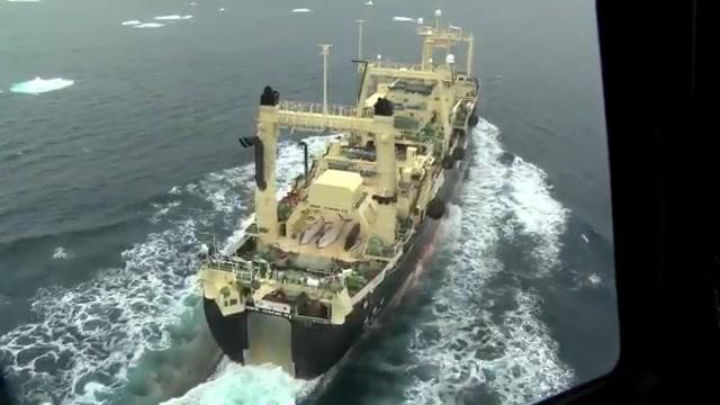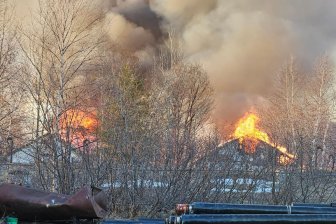WARNING: The video below contains graphic content. Viewer discretion is advised.

Conservation group Sea Shepherd has claimed it chased a Japanese whaling vessel out of protected waters, but not before at least four whales had been caught and killed.
Each year, during summer in the Antarctic, Japan’s fleet of whalers carry out a hunt, purportedly for scientific purposes.
Year after year, Sea Shepherd follows and confronts the whaling vessels in an effort to chase out the whalers.
But Sea Shepherd is alleging the Japanese Nisshin Maru entered into New Zealand’s territorial waters in the Ross Sea and the area known as the Southern Ocean Sanctuary, where commercial whaling is prohibited.
The activist group also posted video online of three dead minke whales on board the factory ship.
The group also filmed whalers butchering a fourth whale, also thought to be a minke whale, on the blood-splashed deck.
WARNING: The video below contains graphic content. Viewer discretion is advised.
Sea Shepherd also claimed the whalers had entered into what are considered to be New Zealand territorial waters, but the government refuted that claim.
New Zealand Foreign Minister Murray McCully said the area is not under his country’s jurisdiction, the Guardian Australia reported.
“New Zealand has responsibility for coordinating search and rescue operations in a large area in the Southern Ocean, however these are international waters and not within New Zealand’s maritime jurisdiction,” he said.
Sea Shepherd Australia chairman Bob Brown accused the New Zealand and Australia governments of “sitting on their hands” and allowing “criminal activity” to go on.
“It’s just a gruesome, bloody, medieval scene which has got no place in this world,” Brown told media in Sydney, Australia.
Both the New Zealand and Australian government have taken measures to keep tabs on the Japanese whaling fleet and the activities of anti-whaling activists.
- Ontario takes action against chemical plant after Aamjiwnaang First Nation residents fell ill
- High benzene levels detected near Ontario First Nation for weeks, residents report sickness
- Beijing orders Apple to pull WhatsApp, Threads from its China app store
- Fishing vessel with crane, net arrives in Zeballos for orca calf rescue
Australia has tasked a surveillance plane to monitor this season’s hunt, while the New Zealand government has its HMNZS Otago on patrol in its southern ocean territory during whaling season.
Australia is also awaiting a ruling from the International Court of Justice (ICJ), which concluded public hearings last July.
Australia requested the ICJ “declare that, by its conduct, Japan has violated its international obligations pursuant to the International Convention for the Regulation of Whaling.”
Those obligations include observing a “zero catch limit in relation to the killing of whales for commercial purposes,” to “refrain from undertaking commercial whaling of fin whales in the Southern Ocean Sanctuary” and to “observe the moratorium on taking, killing or treating whales, except minke whales, by factory ships or whale catchers attached to factory ships.”
A spokesperson for Japan’s Fisheries Agency told the Japan Times the whaling fleet is acting “in line with a research plan submitted to the IWC,” and that the agency was “not aware of the existence of a whaling sanctuary.”
Although the whale carcasses seen aboard the Nisshin Maru were minke whales, the Japanese fleet includes fin whales in its annual hunt, purportedly for scientific purposes.
According to the Guardian, the Japanese fleet has a quota of 935 minke whales and 50 fin whales this season.
Last year, the fleet caught 103 minke whales in the Antarctic, not even one-third of its intended catch.
In the 2011-2012 season, the whalers killed 445 whales — including 297 minke whales, 50 Bryde’s whales, two fin whales, 95 sei whales and one sperm whale — according to the U.S. advocacy group Whale and Dolphin Commisson.
Although Japan attests the hunt is for scientific purposes, whale meat is found at grocery stores and at restaurants.
Sea Shepherd, founded by Toronto-born and New Brunswick-raised activist Paul Watson, has for years been trying to halt the Japanese hunt.
Japan has requested an Interpol “Red Notice” warrant for Watson’s arrest, having charged him in 2010 in connection with incidents involving a Japanese ship.
He was also wanted on a separate “Red Notice” requested by the government of Costa Rica, after a 2002 confrontation with a shark-finning operation. German authorities arrested him in Frankfurt in July 2012, but he skipped bail and remained a fugitive until the “Red Notice” was dropped in Nov. 2013.
Sea Shepherd has in the past wound up in a number of altercations with the Japanese fleet.
The group currently has three vessels of its own in the area — the Steve Irwin, the Bob Barker and the Sam Simon.
The Sam Simon is named for the co-creator of The Simpsons, who is dying of cancer and has allotted a chunk of his wealth to animal rights causes.
He accompanied actress Pamela Anderson to St. John’s, N.L. last month, where the pair offered a $1-million cheque to any seal hunters willing to give up the hunt. Local critics said it was nothing more than a publicity stunt and Simon and Anderson were met by a group of counter-protesters and hecklers.




Comments